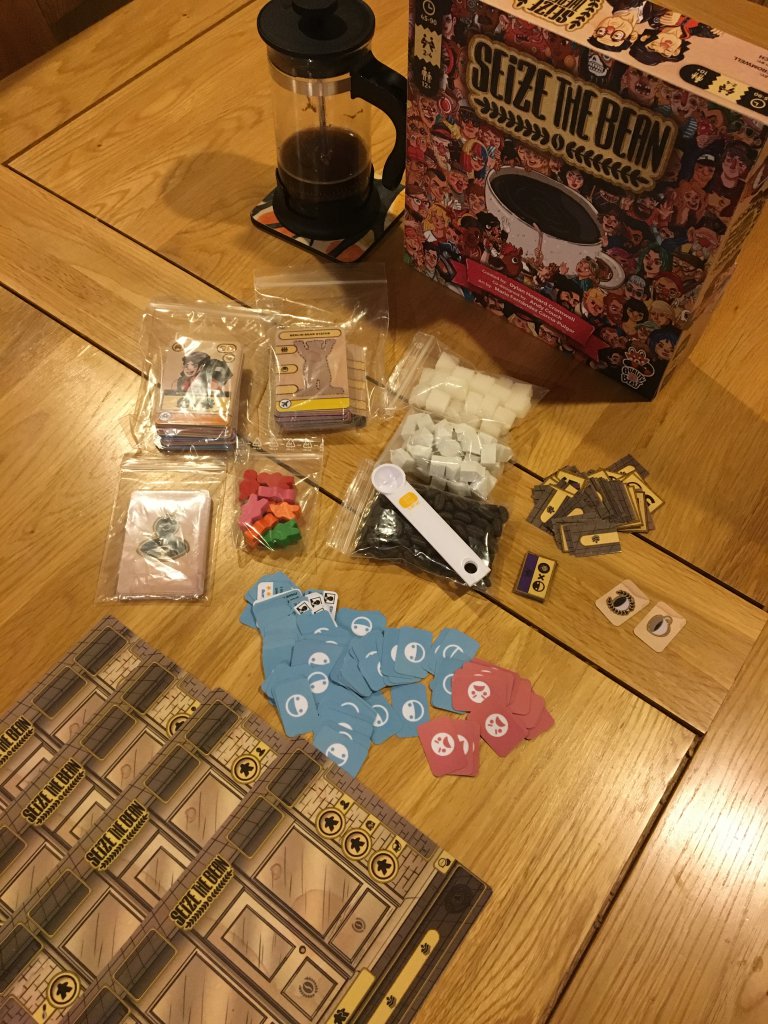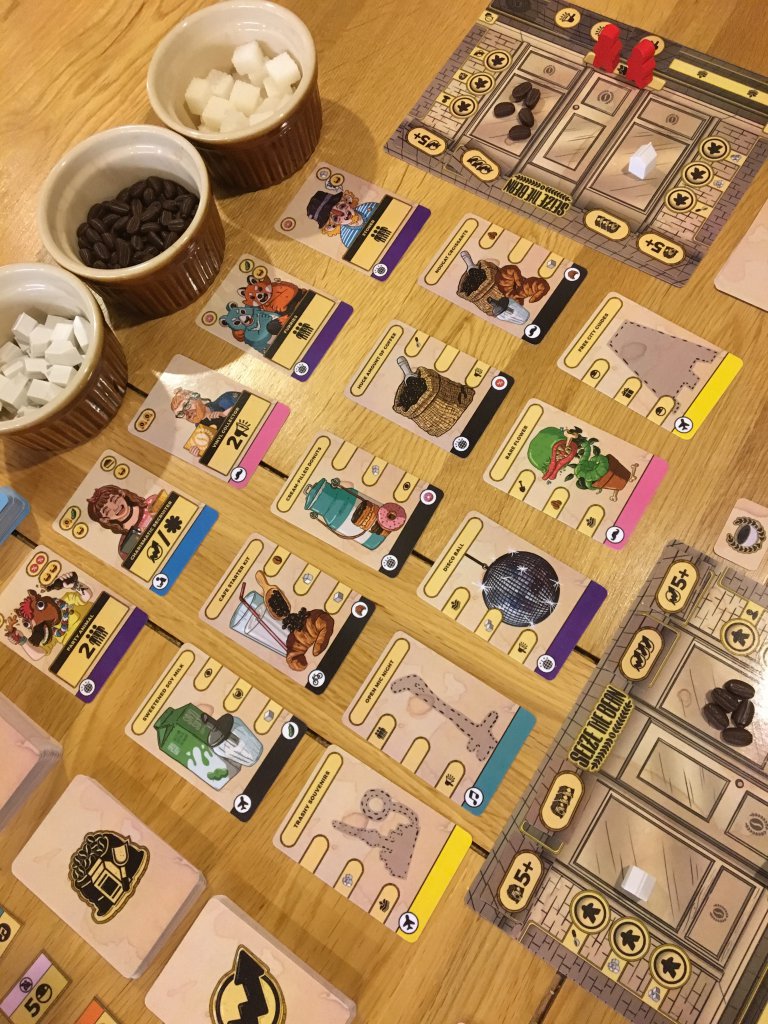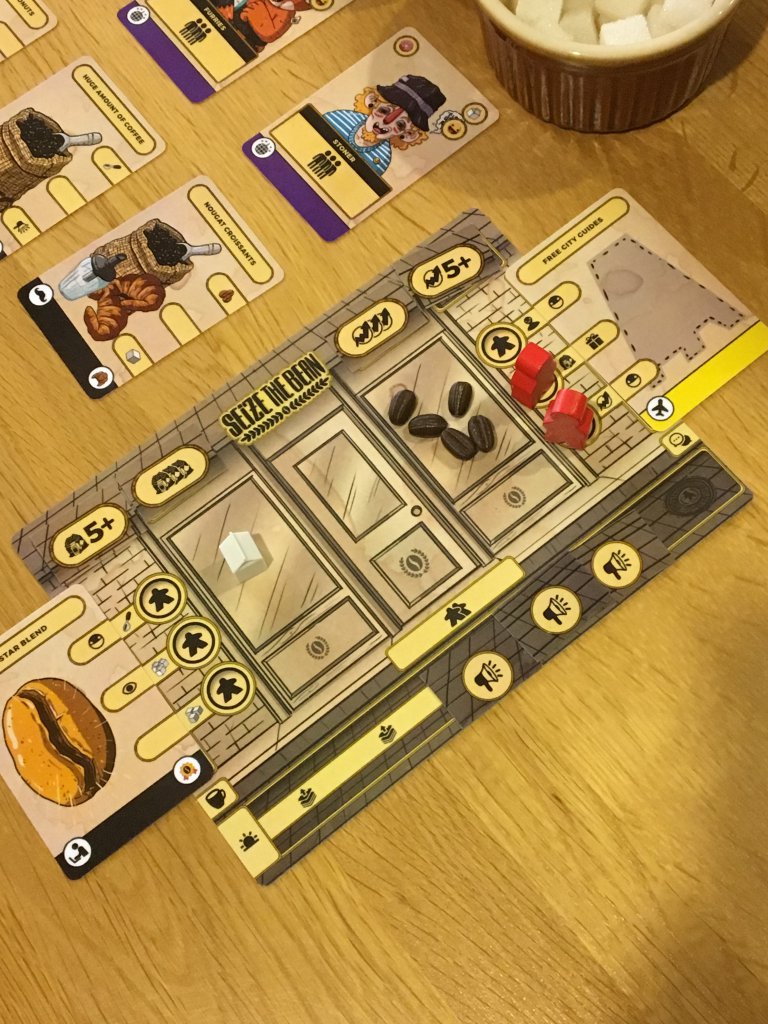Set in the bustling metropolis of Berlin, Seize the Bean is a worker-placement, card-drafting and engine-building game currently active (and funded) on Kickstarter. In the same way as games like Viticulture and Charterstone, Seize the Bean places an interesting and engaging theme at the centre of game systems. In Seize the Bean, players compete to build the most appealing café, attract the best clientele and stock the goods needed to service them.
Given it is currently still in pre-production, Seize the Bean already feels like a surprisingly well-rounded and complete venture. It features distinctive artwork and cute, realistic supply tokens to go alongside good and bad review tokens, score and hype tokens, various city cards and a player mat each. A couple of meeples complete the kit for each cafe, which means that Seize the Bean has the potential to be a fairly compact (portable, even) game if you want it to be.
Game structure in Seize the Bean is incredibly simple, to the point that even breaking it down into its four constituent phases makes it sound more complicated than it is.
Firstly, any customers in the queue must be served, which involves spending coffee, milk and sugar supplies to make customers happy enough to give good reviews, which in turn act as victory points. Serving customers is where the deck-building element of the game comes into play, but I’ll cover that in more detail in a moment.

The second (and arguably main) phase is the Action round. Players take it in turns to place one of their two baristas (there is currently no mechanism to expand your workforce) onto one of six actions. The three actions on the left of the player board involve drawing coffee, milk and sugar resources from the supply, whilst the three right-hand actions let players take customer, product or upgrade cards from the city and place them (in the case of customers) into their customer deck, or onto the café itself in the case of products or upgrades.
The Word of Mouth phase comes next, which (depending on your strategy and how late into the game you are) is probably the main way for players to influence how customers enter their café. As your café expands outwards via the product and upgrade cards you place on either side, new symbols begin to appear.
Each of these symbols (such as a bike or an instrument) relate to groups of customers such as cyclists and musicians. The final number of available customer groups will depend on the success of the Kickstarter, but each group comes with matching product and upgrade cards to ensure viability, with the number of customer groups used dictated by the number of players in the game. This adds the possibility for variation, because each customer includes a ‘special ability which only becomes available when you fulfill the customer’s primary need. Special abilities tend to include attracting walk-in customers, taking a bonus action or something similar.

The final phase of Seize the Bean is effectively a clean-up phase called The End of the Day, during which players reset their workers; draw customers from their deck to form the queue for the next morning; move cards down the city track by stacking the second-to-last card onto the end one (burying it); then drawing a fresh card for each category and placing it onto the city. Buried cards can sometimes be accessed by special abilities, but in general this approach is used to ensure that new customers, products and upgrades are made available each turn.
When placing new customers during this End of the Day phase, cards are drawn from a deck held by each individual player, made up of the customers they have attracted during the Action and Walk In phases (as well as the four Friends and Family customers all players begin with). The number of customers placed in the café is equal to its current hype value, which begins at two and can be expanded by certain upgrades and customers — including Hipsters, for example. Serving more customers is a good way to score Good Reviews, but the more you need to serve, the more raw materials you need in your supply.
Actually doing the serving is another simple process, although as I played more and more of Seize the Bean, I learned how interesting it becomes as more complex customers are introduced. At the most simple level, customers have a base requirement shown in the top left of the card. Fulfilling it always unlocks the customer’s special ability and will sometimes generate a Good Review.

Many customers then have a secondary requirement for something more complex, like a cake, which can either be met with two of a basic resource (two coffee beans for premium coffee, for example) or by one resource if you have the relevant symbol on one of your product cards. For example, if you have a ‘Cream Filled Donut’ product, you will also have a donut symbol which lets you meet the need for donuts cheaply. Secondary objectives almost always result in at least one Good Review, with some giving two.
Failure to meet the basic need of a customer results in an impatience token, which flips to a Bad Review at the end of the service phase. Players do not have a choice about serving customers if they can and each must be served in order, so there’s no option to cherry pick your favorite customers from the queue. In the event a player can’t serve one or more customers, then other players (other cafés, if you will) may serve them and take the benefit of doing so. There is a rule around stealing customers from other players in this way if the owner fails to meet their need three times, but I found them a little hard to track, so in the end I either ignored the rule or used a variant rule which allows the customer to be stolen the first time their needs are unfulfilled.
Building a customer deck (which thematically represents the regular customers that baristas in every coffee shop come to know and love) whilst also balancing product supply and expanding the café is the core of Seize the Bean. Good players need to control the kind of customer that visits them whilst also building their victory point engine. Some upgrades outright contribute Good Reviews when certain actions are taken, so there are certainly a number of ways to win the game.

Even though my copy features only a small number of the customer groups that will be available in the final product, there are a number of things I enjoyed about Seize the Bean. For starters, the game has a really tight bond between theme, artwork and gameplay mechanics, which together form a tight, cohesive experience. Gameplay itself is fast and fun, with a clear, concise range of actions that become increasingly complex and powerful in a linear, straightforward way as the café expands.
In terms of point-scoring mechanics, Good Reviews can be generated in several ways, including directly from customers, via upgrades to the cafe or from some of the relatively valuable Player Board objectives. I’ve won and lost games based on each of these strategies and whilst some options can be better than others based on the available city cards, taking it in turns to perform a single action generally means everyone is able to focus on their preference without feeling materially disadvantaged by what someone else is doing.
Whilst we don’t give final verdicts for preview products, I’d like to repeat that I do feel that Seize the Bean feels very close to complete in terms of base mechanics, style and appearance. The rulebook is still a work in progress, but I believe that I have interpreted the game correctly based on its current state and I have no reason to think that the finalised version won’t be up to scratch. Similarly, I haven’t seen the finalised tokens or cards, but I suspect they’ll be up to at least the same standard as any other game. As a result, I feel relatively confident in suggesting that Seize the Bean is a game I think I’ll be backing, and therefore if it sounds at all appealing to you, you should too.
An early version of Seize The Bean (featuring sample components) was provided by Quality Beast for the purposes of this preview. Seize The Bean is currently on Kickstarter until February the 15th and has already reached both its funding goal and a number of its stretch goals, including the lifelike components shown in this review.
Comments are closed.